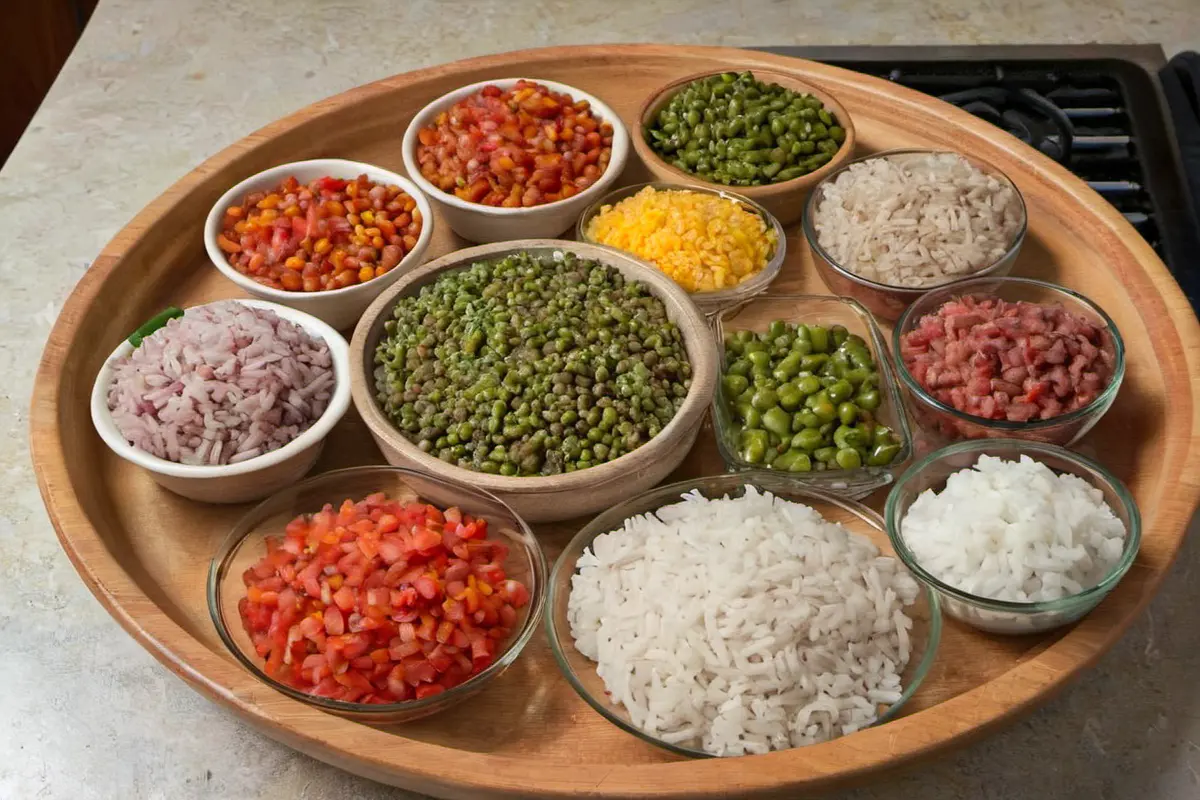Have you ever wondered, Does Arroz con Gandules contain pork? This beloved dish, pivotal to Puerto Rican cuisine, varies widely in its preparation. Today, we’re diving deep into its traditional ingredients, exploring regional variations, and uncovering the secrets behind its rich flavors. Whether you’re a seasoned chef or a curious foodie, this exploration will enhance your understanding and appreciation of Arroz con Gandules.
Introduction to Arroz con Gandules
Understanding the Core Ingredients
Arroz con Gandules, the quintessential Puerto Rican dish, serves as more than just a meal; it’s a cultural icon. But what exactly goes into this celebrated dish? At its heart, Arroz con Gandules combines rice and pigeon peas, known locally as gandules, with a flavorful blend of herbs and spices. The foundation of its unique taste lies in sofrito, a mix of onions, peppers, garlic, and herbs sautéed to perfection.
Interestingly, while some might assume that pork is a standard ingredient, it’s actually optional. This dish’s flexibility allows it to cater to various dietary preferences, making it a versatile option for many occasions. Incorporating pork typically involves diced ham or bacon, adding a rich, savory depth to the rice.
So, does Arroz con Gandules contain pork? Yes and no. The choice is up to the cook, influenced by personal taste and tradition. As we proceed, we’ll explore how this dish can vary and why it remains a staple at Puerto Rican gatherings. Whether it’s a holiday, a family reunion, or just a weekday dinner, Arroz con Gandules stands as a testament to the island’s rich culinary heritage.
Main Ingredients of Arroz con Gandules
Exploring the Use of Pork in Arroz con Gandules
Pork in Arroz con Gandules
When it comes to Arroz con Gandules, the main question often is: Does Arroz con Gandules contain pork? Traditionally, the answer varies significantly across different recipes and regional preferences within Puerto Rico. Although pork is not a mandatory ingredient, many variations of the dish commonly include it, adding a cherished layer of flavor.
Variations and Regional Preferences
The use of pork in Arroz con Gandules can range from diced ham, bacon, or even salt pork. Each type of pork lends a unique flavor profile to the dish, enhancing the savory notes of the sofrito base. However, for those who prefer a lighter or vegetarian version, the pork can be easily omitted without losing the essence of this classic dish.
The Role of Sofrito
What makes Arroz con Gandules particularly special is the sofrito—a vibrant, aromatic paste that serves as the backbone of many Caribbean dishes. Sauté peppers, onions, garlic, and a mix of herbs to release their full flavors in sofrito before mixing with rice and pigeon peas. The addition of sazón, a seasoned salt blend frequently containing annatto for coloring, imparts the characteristic yellow or orange tint to the rice, enhancing the dish’s visual appeal as much as its flavor.
Sazón and Colorful Presentation
For those who are curious about preparing Arroz con Gandules, remember, the pork is optional but highly recommended for those who appreciate its depth of flavor. If you’re looking for more detailed guidance on creating this dish authentically, consider exploring this comprehensive guide on how to prepare authentic Puerto Rican Arroz con Gandules.
Cooking Tips and Recommendations
As we delve further into the traditional methods and utensils used for cooking Arroz con Gandules, we’ll discover how each element contributes to the dish’s distinctive character. Whether you’re using a traditional caldero or a modern Dutch oven, the cooking process allows each ingredient to meld beautifully, creating a dish that’s both comforting and richly flavored.

Traditional Cooking Methods and Utensils
Traditional Cooking Methods and Essential Utensils
Mastering the art of making Arroz con Gandules goes beyond just knowing whether it contains pork. It’s equally important to use the right tools and techniques to bring out the dish’s authentic flavors. Central to this process is the use of a caldero, a traditional cooking pot that’s key to Puerto Rican cuisine.
The Role of the Caldero in Puerto Rican Cooking
A caldero is essentially a type of Dutch oven typically made from cast aluminum. Its thick construction allows for even heat distribution, which is crucial for perfectly cooked rice. The caldero’s design also helps to seal in moisture, ensuring that the rice remains tender and the flavors concentrated. This pot is not just for making Arroz con Gandules; it’s versatile enough for a variety of other dishes, from stews to roasted meats.
Step-by-Step Cooking Process
When cooking Arroz con Gandules, the process starts by heating oil in the caldero. Once hot, add sofrito and sauté until fragrant. If using pork, add it at this stage to render and flavor the oil. Then, combine rice, pigeon peas, and water or broth with the sofrito. Stir in key seasonings like sazón and bay leaves to infuse the rice with their distinct flavors.
Achieving the Perfect Texture
When preparing this dish, mastering the cooking procedure is vital. After the mixture reaches a boiling point, lower the heat and cover the caldero. The rice must simmer gently, allowing it to absorb all the flavors while becoming fluffy and tender. Stirring too often can break the grains or lead to a sticky texture, so it’s generally advised to let it cook undisturbed until most of the liquid is absorbed.
Properly using traditional tools and techniques can transform Arroz con Gandules into a dish that not only satisfies hunger but also comforts the soul. This method of cooking not only preserves the dish’s heritage but also enhances its flavors, making each bite a testament to the rich culinary traditions of Puerto Rico. As we move on to explore dietary considerations and substitutions, we’ll see how this adaptable dish can meet the needs of various diets while maintaining its delightful essence.


